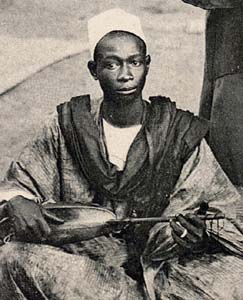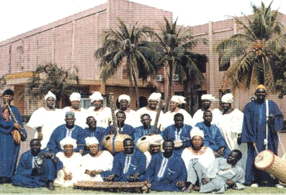
The Music of Mali is, like that of most African nations, ethnically diverse, but one influence predominates; that of the ancient Mali Empire of the Mandinka. Mande people make up 50% of the country's population, other ethnic groups include the Fula (17%), Gur-speakers 12%, Songhai people (6%), Tuareg and Moors (10%) and another 5%, including Europeans. Mali is divided into eight regions; Gao, Kayes, Koulikoro, Mopti, Ségou, Sikasso, Tombouctou and Bamako.
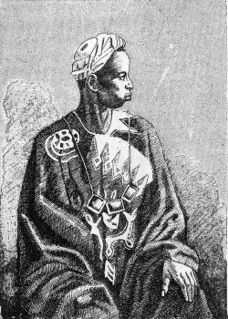
A griot, is a West African historian, storyteller, praise singer, poet, or musician. The griot is a repository of oral tradition and is often seen as a leader due to his or her position as an advisor to royal personages. As a result of the former of these two functions, they are sometimes called a bard.

The Mandinka, or Malinke, are a West African ethnic group primarily found in southern Mali, eastern Guinea and northern Ivory Coast. Numbering about 11 million, they are the largest subgroup of the Mandé peoples and one of the largest ethnic groups in Africa. They speak the Mandinka language, which is one of the Western Manding languages in the Mande language family and a lingua franca in much of West Africa. Over 99% of Mandinka adhere to Islam. They are predominantly subsistence farmers and live in rural villages. Their largest urban center is Bamako, the capital of Mali, which is also inhabited by the closely related Bambara.
The Mande languages are spoken in several countries in West Africa by the Mandé peoples and include Maninka, Mandinka, Soninke, Bambara, Kpelle, Dioula, Bozo, Mende, Susu, and Vai. There are "60 to 75 languages spoken by 30 to 40 million people", chiefly in Burkina Faso, Mali, Senegal, the Gambia, Guinea, Guinea-Bissau, Sierra Leone, Liberia, and Ivory Coast. The Mande languages have traditionally been considered a divergent branch of the Niger–Congo family; however that categorisation has been controversial.
Sundiata Keita was a powerful prince and founder of the Mali Empire. The famous Malian ruler Mansa Musa, who made a pilgrimage to Mecca, was his great-nephew.

The Songhai people are an ethnic group in West Africa who speak the various Songhai languages. Their history and lingua franca is linked to the Songhai Empire which dominated the western Sahel in the 15th and 16th century. Predominantly a Muslim community, the Songhai are found primarily throughout Mali in the Western sudanic region. The name Songhai was historically neither an ethnic nor linguistic designation, but a name for the ruling caste of the Songhay Empire. Speakers in Mali have adopted it as an ethnic designation but other Songhay-speaking groups identify themselves by other ethnic terms such as Zarma or Isawaghen. The dialect of Koyraboro Senni spoken in Gao is unintelligible to speakers of the Zarma dialect of Niger, according to at least one report. The Songhay languages are commonly taken to be Nilo-Saharan but this classification remains controversial: Dimmendaal (2008) believes that for now it is best considered an independent language family.
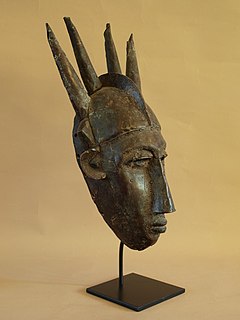
Mandé is a family of ethnic groups in Western Africa who speak any of the many related Mande languages of the region. Various Mandé groups are found in Benin, Burkina Faso, Côte d'Ivoire, Gambia, Ghana, Guinea, Guinea-Bissau, Liberia, Mali, Mauritania, Niger, Nigeria, Senegal and Sierra Leone. The Mandé languages are divided into two primary groups: East Mandé and West Mandé.
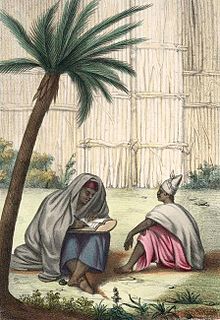
The Toucouleur people, also called Tukulor or Haalpulaar are a West African ethnic group native to Futa Tooro region of Senegal. There are smaller communities in Mali and Mauritania. The Toucouleur were islamized in the 11th century; their early and strong Islamic heritage, which is seen as a defining feature, is a "matter of great pride for them". They have been influential in the spread of Islam to West Africa in the medieval era, later founded the vast Toucouleur Empire in the 19th century under El Hadj Umar Tall that led a religious war against their neighboring ethnic groups and the French colonial forces.
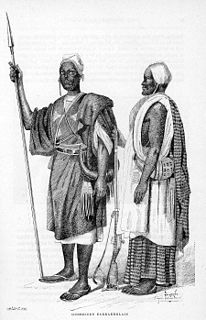
The Soninke are a West African ethnic group found in eastern Senegal and its capital Dakar, northwestern Mali and Foute Djalon in Guinea, The Gambia and southern Mauritania. They speak the Soninke language, also called Maraka language, which is one of the Mande languages. They are one of the richest people in The Gambia Soninke people were the founders of the ancient empire of Ghana c. 750–1240 CE. Subgroups of Soninke include the Maraka and Wangara. When the Ghana empire was destroyed, the resulting diaspora brought Soninkes to Mali, Senegal, Mauritania, Gambia, Burkina Faso, Ghana, and Guinea-Bissau where some of this trading diaspora was called Wangara.
The Sundiata Keita or Epic of Sundiata is an epic poem of the Malinke people that tells the story of the hero Sundiata Keita, the founder of the Mali Empire. The epic is an instance of oral tradition, going back to the 13th century and narrated by generations of griot poets or jeliw (djeli). There is no single or authoritative version. Material pertaining to the epic first began to be collected during the early 20th century in French Sudan, notably by the French elite school École William Ponty, resulting in the "modern" version of the tale as considered standard today, as published in "novelistic" form in French translation by Djibril Tamsir Niane in 1960.

The Wolof people are a West African ethnic group found in northwestern Senegal, the Gambia, and southwestern coastal Mauritania. In Senegal, the Wolof are the largest ethnic group (~43.3%), while elsewhere they are a minority. They refer to themselves as Wolof and speak the Wolof language, in the West Atlantic branch of the Niger–Congo family of languages.
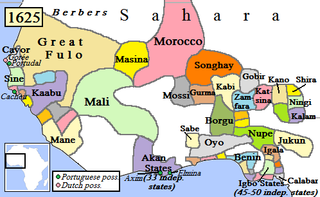
The Kaabu Empire (1537–1867), also written Gabu, Ngabou, and N'Gabu, was a Mandinka empire of Senegambia centered within modern northeastern Guinea-Bissau, larger parts of today's Gambia; extending into Koussanar, Koumpentoum, regions of Southeastern Senegal, and Casamance in Senegal. It rose to prominence in the region thanks to its origins as a former imperial military province of the Mali Empire. After the decline of the Mali Empire, Kaabu became an independent Empire. Kansala, the imperial capital of Kaabu Empire, was annexed by Futa Jallon during the 19th century Fula jihads. However, Kaabu's vast independent kingdoms across Senegambia continued to thrive even after the fall of Kansala; this lasted until total incorporation of the remaining Kingdoms into the British Gambia, Portuguese and French spheres of influence during the Scramble for Africa.
Daniel Laemouahuma Jatta is a Jola scholar and musician from Mandinary, Gambia, who pioneered the research and documentation of the akonting, a Jola folk lute, as well as the related Manjago folk lute, the buchundu, in the mid-1980s. Prior to Jatta's work, these instruments were largely unknown outside the rural villages of the Senegambia region of West Africa.
Caste systems in Africa are a form of social stratification found in numerous ethnic groups, found in over fifteen countries, particularly in the Sahel, West African and North African region. These caste systems feature endogamy, hierarchical status, inherited occupation, membership by birth, pollution concepts and restraints on commensality.
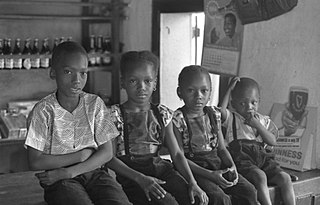
The Temne people, also called Atemne, Témené, Temné, Téminè, Temeni, Themne, Thimni, Timené, Timné, Timmani, or Timni, are a West African ethnic group. They are predominantly found in the Northern Province of Sierra Leone. Some Temne are also found in Guinea. The Temne constitute the second largest ethnic group in Sierra Leone, at 31.6% of the total population, which is slightly less than the Mende people at 32.2%. They speak Temne, a Mel branch of the Niger–Congo languages.

The Zarma people are an ethnic group predominantly found in westernmost Niger. They are also found in significant numbers in the adjacent areas of Nigeria and Benin, along with smaller numbers in Burkina Faso, Ivory Coast, Ghana, Togo, and Cameroon.

The Susu people, also spelled Soosoo, Sossoe, Sosoe, Soso, Sossé, Sosso, Sousou, Susa, Susoo, Susso, Sussu, Suzée, or Soussou, are a West African ethnic group, one of the Mandé peoples living primarily in Guinea and Northwestern Sierra Leone, particularly in Kambia District. Influential in Guinea, smaller communities of Susu people are also found in the neighboring Guinea-Bissau, Senegal.
The Serer people are a West African ethnoreligious group. They are the third largest ethnic group in Senegal making up 15% of the Senegalese population. They are also found in northern Gambia and southern Mauritania.
The Jakhanke also spelled Jahanka, Jahanke, Jahanque, Jahonque, Diakkanke, Diakhanga, Diakhango, Dyakanke, Diakhanké, Diakanké, or Diakhankesare are a Manding-speaking ethnic group in the Senegambia region, often classified as a subgroup of the larger Soninke. The Jakhanke have historically constituted a specialized caste of professional Muslim clerics (ulema) and educators. They are centered on one larger group in Guinea, with smaller populations in the Gambia, Senegal, and in Mali. In Guinea and nearby regions, they speak a Manding language called Jahanke, very similar to Western Malinke.
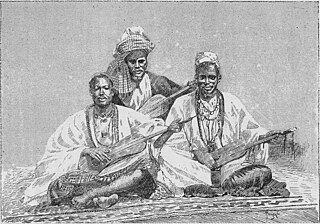
Circa 1230s-1600s, the MaliEmpire was created in Western Africa along the Niger River. Often associated with being founded by Sunjata Keita, the history of Mali is extremely based on oral history. The story of the founder of Mali, Sunjata Keita, is largely based on oral history. Oral history may be defined as the preservation and interpretation of historical, cultural or personal experiences by way of a speaker. In Mali, such a speaker can be described as a poet, a storyteller, a praise singer or a musician. A large amount of Mali’s history is transferred via oral historians. Such oral historians in Mali are known as griots, Jalis, and Jelis. The origins of oral history in Mali may be traced back to the story of Sunjata Keita. Modern-day oral history in Mali has transformed from the history based griots to a more contemporary musical and negotiator based griots. The current state of oral history in Mali has travelled to other realms like popular culture and politics.
